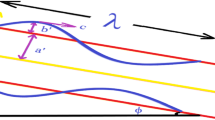Abstract
In order to correctly predict tube cross section time-smoothed velocity distribution, friction factor and mass transfer behavior, two models for turbulent flow in circular tubes based on classical Prandtl mixing length theory and a modified mixing length were established. The results show that the modified mixing length includes the introduction of a damping function for the viscous sublayer and the second-order derivative to approximate eddy velocity. The calculated dimensionless time-smoothed velocity from the model based on Prandtl mixing length is much better than the result from the concept of eddy viscosity. The calculated eddy viscosity from the model based on modified mixing length is much better than the result from the model based on the classical Prandtl mixing length theory. And the friction factor calculated from the model based on the modified mixing length agrees well with the reported empirical relationships.
Similar content being viewed by others
References
ZHANG Zhao-shun, CUI Gui-xiang, XU Chun-xiao. Theory and modeling of turbulence [M]. Beijing: Tsinghua University Press, 2005.
HE S, JACKSON J D. A study of turbulence under condition of transient flow in a pipe [J]. Journal of Fluid Mechanics, 2000, 408:1–38.
MORSI Y S M, HOLLAND P G, CLAYTON B R. Prediction of turbulent swirling flows in axisymmetric annuli [J]. Applied Mathematical Modelling, 1996, 19(10): 613–620.
PRIYMAK V G, MIYAZAKI T. Accurate navier-stokes investigation of transitional and turbulent flows in a circular pipe [J]. Journal of Computational Physics, 1998, 142(2): 370–411.
COTTON M A. Resonant response in periodic turbulent flows: Computations using a k-ɛ eddy viscosity model [J]. Journal of Hydraulic Research, 2007, 45(1): 54–61.
CHANDESRIS M, SERRE G, SAGAUT P. A macroscopic model for flow in porous media suited for channel, pipe and rod bundle flows [J]. International Journal of Heat and Mass Transfer, 2006, 49(15/16):2739–2750.
CRUZ D O A, PINHO F T. Turbulent pipe flow predictions with a low Reynolds number k-ɛ model for drag reducing fluids [J]. Journal of Non-Newtonian Fluid Mechanics, 2003, 114(2/3): 109–148.
RICE M, HALL J, PADADAKIS G, YIANNESKIS M. Investigation of laminar flow in a stirred vessel at low Reynolds numbers [J]. Chemical Engineering Science, 2006, 61(9): 2762–2770.
FIOFFMAN J, JOHNSON C. A new approach to computational turbulence modeling [J]. Computer Methods in Applied Mechanics and Engineering, 2006, 195(23/24): 2865–2880.
IIZUKA S, KONDO H. Large-eddy simulation of turbulent flow over complex terrain using modified static eddy viscosity models [J]. Atmospheric Environment, 2006, 40(5): 925–935.
FRISCH U. Turbulence [M]. London: Cambridge University Press, 1995.
REICHARDT H. Complete representation of a turbulent velocity distribution in smooth tubes [J]. Journal of Applied Mathematics and Mechanics, 1951, 31(7): 208–219.
DJORDJEVIC V D. A higher-order asymptotic theory for fully developed turbulent flow in smooth pipes [J]. Journal of Engineering Mathematics, 1998, 33(3): 237–250.
BIRD R B, STEWART W E, LIGHTFOOT E N. Transport phenomena [M]. New York: John Wiley & Sons Inc, 2002.
ZYABRIKOV V V, LOITSYANSKII L G. The damping factor in the theory of Prandtl mixing length [J]. Fluid Dynamics, 1987, 22(5):695–701
BRADSHAW P. Turbulence [M]. Heidelberg: Springer-Verlag, 1976.
ABBOTT D E, WALKER J D A, YORK R E. Numerical solution of turbulent boundary layers approaching separation [C]// ROBERT D R. Proceedings of the Fourth International Conference on Numerical Methods in Fluid Dynamics. Heidelberg: Springer-Verlag, 1975: 34–39.
HANNA O T, SANDALL O C, MAZET P R. Heat and mass transfer in turbulent flow under conditions of drag reduction [J]. American Institute of Chemical Engineering Journal, 1981, 27(4): 693–697.
LIN C S, MOULTON R W, PUTNAM G L. Mass transfer between solid wall and fluids streams [J]. Industrial Engineering Chemistry, 1953, 45(3): 636–640.
BARENBLATT G I. Scaling, self-similarity, and intermediate asymptotics [M]. London: Cambridge University Press, 1996.
Author information
Authors and Affiliations
Corresponding author
Additional information
Foundation item: Project(20736009) supported by the National Natural Science Foundation of China; Project(07JJ6017) supported by the Natural Science Foundation of Hunan Province, China
Rights and permissions
About this article
Cite this article
Luo, X., Liu, Pl. & Luo, Ha. Improvement of Prandtl mixing length theory and application in modeling of turbulent flow in circular tubes. J. Cent. South Univ. Technol. 15, 774–778 (2008). https://doi.org/10.1007/s11771-008-0143-3
Received:
Accepted:
Published:
Issue Date:
DOI: https://doi.org/10.1007/s11771-008-0143-3




